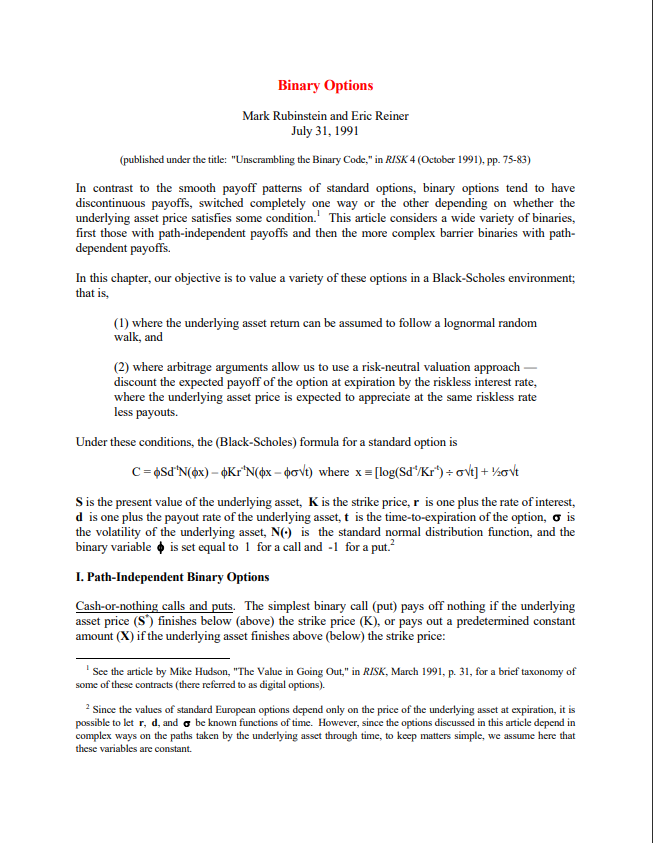Binary Options Mark Rubinstein and Eric Reiner

0 if φS* ≤ φK, or X if φS* > φK
with φ = 1 for a call, and φ = –1 for a put.
In a Black-Scholes environment, such an option is easy to value. Recall that the Black-Scholes
formula can be decomposed into the difference between two terms: the unprotected present value
of the underlying asset price conditional upon exercising the option – Sd-tN(φx) – and the present
value of the strike price – Kr-t – times the risk-neutral probability of exercising the option – N(φx –
φσ√t). If the predetermined payoff of the cash-or-nothing call (X) were equal to the strike price
(K), then a cash-or-nothing call would be like a standard written call except that, although the
writer receives the strike price, he is under no obligation to deliver the underlying asset. Such a
"partial call" would be then be worth Kr-tN(x – σ√t) to the writer. More generally, allowing X ≠
K, the value of a cash-or-nothing call would be Xr-tN(φx – φσ√t) with φ = 1. Similarly, the value
of a cash-or-nothing put is the same, but with φ = –1 .
Asset-or-nothing calls and puts.
A somewhat more complex binary option has the following
payoffs:
0 if φS* ≤ φK, or S* if φS* > φK
These options are similar to cash-or-nothing options, except that when they pay off, the amount is
not predetermined but rather is equal to the underlying asset price at expiration. To value these, we
look instead to the first term of the Black-Scholes formula. This gives us exactly what we need:
the unprotected present value of the underlying asset price conditional upon exercising the option.
So the value of an asset-or-nothing call is simply Sd-tN(φx) with φ = 1, and the value of an asset-
or-nothing put is the same, but with φ = –1.
Gap options. Our next options are just slightly more complex than standard options:
0 if φS* ≤ φK, or φS*– φX if φS* > φK
These options highlight the dual role played by the strike price in a standard option: K not only
determines whether the option finishes in- or out-of-the-money but also the size of the resulting
payoff (X). There is no logical necessity for these two functions to be vested in a single number.
The "gap" is defined as X – K. Positive gap calls will clearly sell for less than standard calls while
positive gap puts will be worth more than their standard counterparts. The value of a gap option
may be derived by subtracting the value of a cash-or-nothing option from the value of an asset-or-
nothing option:
C = φSd-tN(φx) – φXr-tN(φx – φσ√t) where x ≡ [log(Sd-t/Kr-t) ÷ σ√t] + ½σ√t
almost identical to the Black-Scholes formula for a standard option. In a special case, if X is
chosen so that C = 0, the option is a "pay-later option," since it can be interpreted as if the buyer
pays for the option at expiration, and only if at that time φS* > φK.
Supershares. In an article published in 1976, Nils Hakansson proposed a financial intermediary
that would hold an underlying portfolio and issue claims called "supershares" against this portfolio
to investors.
A supershare is a security, which on its expiration date entitles its owner to a given
dollar value proportion of the assets of the underlying portfolio, provided the value of those assets
on that date lies between a lower value K1 and an upper value K2. Otherwise, the supershare
expires worthless. That is, the payoff is:
0 if S*< K1
S*/K1 if K1 ≤ S*< K2
0 if K2 ≤ S*
It is easy to see that such an option has the same payoff as (1/K1) bullish vertical spreads of asset-
or-nothing calls, where the purchased asset-or-nothing call has strike price K1 and the written
asset-or-nothing call has strike price K2. That is,
C = (Sd-t/K1)[N(x1) – N(x2)]
x1 ≡ [log(Sd-t/K1r-t) ÷ σ√t] + ½σ√t, x2 ≡ [log(Sd-t/K2r-t) ÷ σ√t] + ½σ√t
These securities can be shown to be building blocks for constructing other more common securities
such as purchased standard calls and puts.
Portfolios of binary options. Another way to construct arbitrary piecewise linear payoff patterns is
to make more direct use of cash-or-nothing and asset-or-nothing calls.
For example, consider the
following payoff pattern




